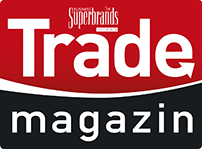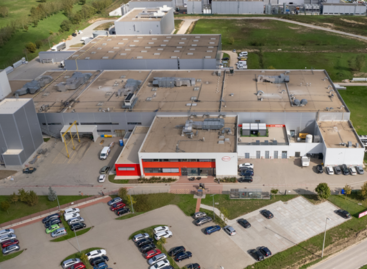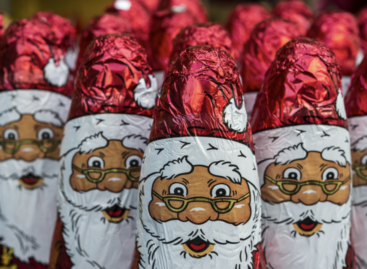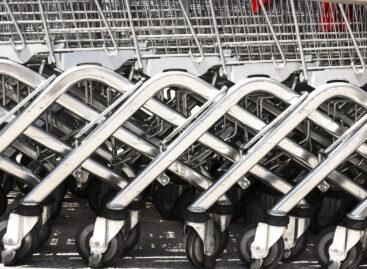Kaufland’s timber prototype: Sustainability meets local anchoring in Slovakia
Kaufland’s store in Záhorská Bystrica is the first Kaufland of its kind in Europe built largely from timber, underlining a shift towards sustainable construction. The prototype combines ecological features with a localized commercial offer. In the store walk, four strategic areas emerged as central to the concept: sustainability, local anchoring, fresh competence, and value-for-money.
The Kaufland in Záhorská Bystrica near Bratislava is a unique store prototype in Europe, combining sustainability with local integration. Built largely from timber and awarded the BREEAM Excellent certificate, an international standard for sustainable buildings, it links ecological design to a localized commercial offer. This dual approach makes the store a symbolic reference point for Kaufland. During the store walk, four areas crystallized as unique value propositions: sustainability, local anchoring, fresh competence, and value-for-money.

Sebastian Rennack
international retail analyst
Aletos Retail
Sustainability as standout hallmark of the visited store
At Záhorská Bystrica, sustainability is presented as a joint concept, balancing environmental responsibility with local anchoring. The 75 percent timber construction sets a European first for Kaufland, complemented by green roofs, retention paving, and biodiversity features such as insect hotels. Photovoltaic panels on the roof supply up to 20 percent of the store’s electricity needs. Together, these measures contribute to the Schwarz Group’s target of reducing CO₂ emissions from operations by 80 percent by 2030.
Local anchoring and Slovak identity
From a commercial perspective, Kaufland makes local anchoring tangible by turning Slovak origin into a visible part of the shopping trip. At the entrance, a wooden board with a heart-shaped Slovak flag quantifies how many Slovak products were sold in the previous month. Inside the store, Slovak identity is communicated through shelf stoppers, price tags, and special ESL frames that highlight domestic and regional origin. The principle extends down to individual categories such as wine from the Bratislava area and the Zlaté Zrnko coffee brand.
Kaufland’s traditional private label K-Z lásky k tradícii (‘Out of love for tradition’) reinforces traditional flavors and is part of a portfolio that positions the retailer as the market leader in Slovak origin displays. According to a 2024 GfK–YouGov survey, Kaufland ranked first among Slovak food retailers with 6,047 displays of Slovak products, increasing its share of domestic product visibility by two percentage points year-on-year and holding the top spot for the eighth consecutive year.
The context is politically charged: Retailers must regularly publish their Slovak product share in the total assortment. Kaufland’s emphasis on local sourcing therefore aligns both with consumer expectations and regulatory realities.
Fresh competence as key differentiator
At a time when Tesco has scaled down fresh counters, Kaufland positions itself as a one-stop-shop destination with a strong fresh focus, exemplified by a stand-alone fish stall offering a broader assortment than competitors. The cheese counter — at other retailers often a purely self-service assortment — offers more than 40 varieties in a serviced format. Meat and delicatessen counters, presented with wooden and graphite tones, create an atmospheric fresh zone consistent with the timber store concept.
Value communication as omnipresent signal
Price leadership is reinforced by Kaufland through an omnipresent value message that builds on its discounter heritage. Throughout the store, ‘Diskontná cena!’ (Discount price) signage, a low-price signalling, is repeated across all categories. In March 2023, at the peak of food inflation, Slovakia recorded the EU’s third-highest food inflation at over 28% year-on-year (Eurostat), which explains why value signalling is indispensable. As in other Kaufland countries, shelf-ready packaging of the entry-price K-Classic brand in red and white further underlines the value promise. Promotions combine affordability with Slovak origin — for example, meat offers link discount communication with domestic sourcing. This dual message strengthens Kaufland’s competitive profile in a market where the recent entry of Polish Biedronka points to further intensifying price competition in the future.
Health, innovation, and modern assortment trends
Visibility of health and innovation trends is part of the commercial concept. Adjacent to the fruit and vegetable department, a vertical farming unit showcases microgreens from the Liptov region. Functional foods are grouped in a dedicated block that combines sports nutrition from the ambient range under the GymBeam brand with chilled high-protein dairy items.
Convenience and digitalization
Simplification and acceleration of the hypermarket trip for time-strapped shoppers is facilitated by K-Scan self-scanning, available in Slovak, English, and German language, addressing both local and cross-border shoppers. Eight self-checkouts are positioned directly at the end of the customer flow from the central aisle. Convenience add-ons, such as a coffee machine at the entrance, further underline Kaufland’s ambition to respond to evolving shopper behavior.
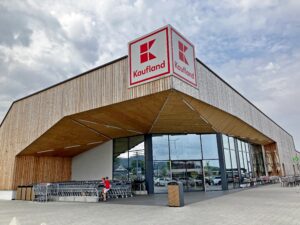
Opened in September 2023, Kaufland’s Záhorská Bystrica branch is the first Kaufland of its kind in Europe built largely from timber. With 75% of the structure made from wood, it stands as a unique flagship for sustainable store construction
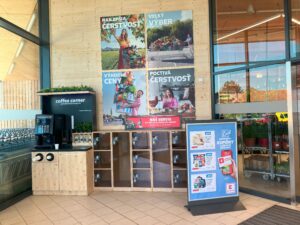
At the store entrance, Kaufland emphasizes freshness, wide choice, and value, while promoting exclusive Kaufland Card prices
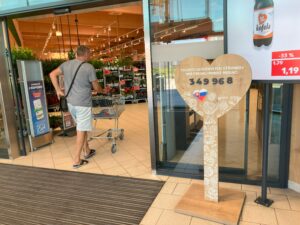
A natural wooden sign with a heart-shaped Slovak flag communicates how many Slovak-made items Kaufland sold last month, emphasizing the chain’s local anchoring
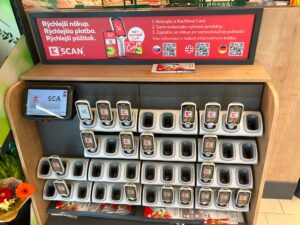
K-Scan self-scanning, a standard feature at Kaufland stores, allows shoppers to scan items directly while shopping and pay at self-checkouts. Instructions are provided in Slovak, English, and German, underlining inclusivity and convenience for both locals and tourists

Marking 25 years in Slovakia, Kaufland emphasizes both its local anchoring ‘With love for Slovakia’ and its value promise ‘Sensationally low prices’. The wooden construction creates a warm and inviting atmosphere that is felt throughout the shopper journey
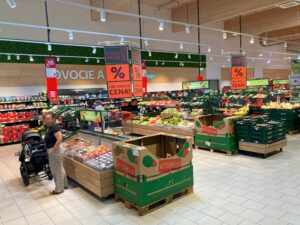
The fruit and vegetable department at the entrance of the store underlines Kaufland’s focus on freshness, supported by bold price communication
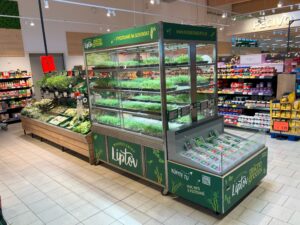
As a beacon of the trend toward micro-local production, Kaufland showcases fresh microgreens grown in-store through vertical farming, positioned adjacent to the fruit and vegetable department. The branded display emphasizes Slovak origin, while dedicated QR codes allow customers to learn more about the supplier
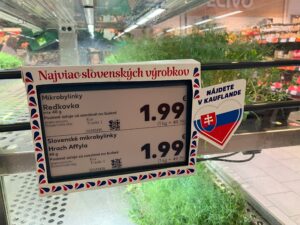
A dedicated ESL price label frame with a heart-shaped Slovak flag creates awareness that shoppers support local producers when buying microgreens. Kaufland combines origin communication with in-store branding to underline its local anchoring

The in-store bakery is positioned as a stand-out department within the customer flow. Its open signage concept is aligned with the store’s timber construction
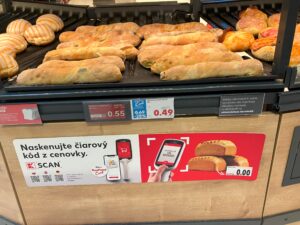
At shelf level, clear signage in Kaufland colors reminds customers to scan shelf labels for loose items without barcodes

A dedicated topical block consisting of two separate shelf end caps presents functional foods: ambient sports nutrition under the GymBeam brand and chilled dairy proteins promoted with ‘Proteins – Energy with taste.’
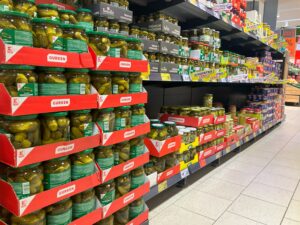
In the dry food section, Kaufland’s entry-price own brand K-Classic is highlighted through red-and-white shelf-ready packaging. The signaling colors build visibility against other brands and clearly communicate value

Also in these ranges, dedicated shelf stoppers highlight Slovak origin. With the heart-shaped flag and origin claims, Kaufland reinforces its positioning as the retailer with the widest offer of Slovak products
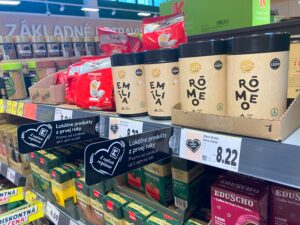
In the coffee category, typically dominated by international brands, Kaufland adds an extra layer of localization. Regional brand Zlaté Zrnko is highlighted with distinctive kraft-paper packaging and black shelf stoppers reading ‘From our regions.’

On the way towards the service counters at the back of the store, Kaufland presents a stand-alone fish stall. With a separately presented assortment that is broader than at other visited competitors, the offer becomes a clear point of differentiation
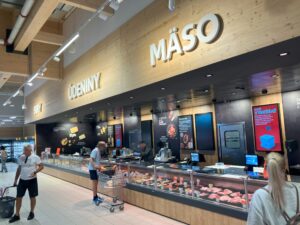
The combination of wooden elements and dark graphite tones in the service department adds a distinct atmosphere that enhances the presentation of fresh products
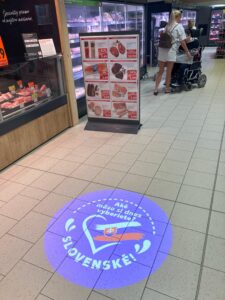
A floor projector highlights Slovak origin with the message ‘What meat will you choose today? Slovak!’ Next to it, promotional posters showcase discounted fresh meat offers, combining Kaufland’s two key USPs: local sourcing and value

A dedicated endcap and department for baby products positions Kaufland as a destination for young families, especially in a market framework, where drugstore competition is less developed than in Germany
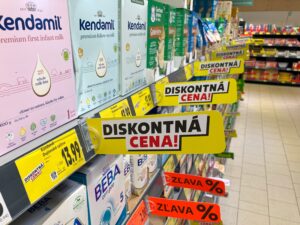
Also in the baby ranges, Kaufland’s ‘Diskontná cena!’ (Discount price) low-price signaling is omnipresent
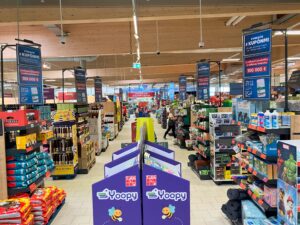
On the way back towards the cash line, overhead signs consistently promote Kaufland’s digital loyalty program, the Kaufland Card
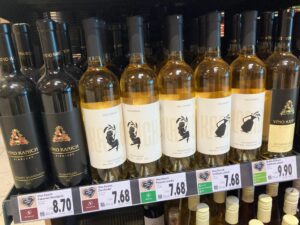
In the wine ranges, special shelf tags highlight regional origin. In this case, wines originating directly from the Bratislava area are emphasized
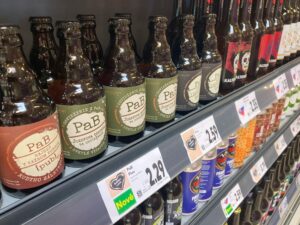
The same applies for locally sourced craft beers
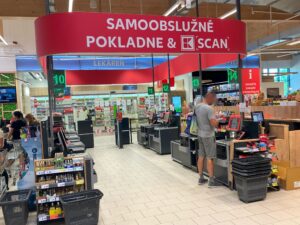
Following the central aisle back towards the cash line, shoppers are guided directly into the area of eight self-checkouts
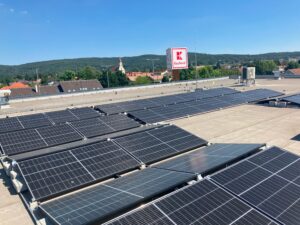
Solar panels on the store roof contribute to Kaufland’s sustainability concept
Related news
Too many gifts, too much food: our holiday excesses are putting a serious strain on the environment
🎧 Hallgasd a cikket: Lejátszás Szünet Folytatás Leállítás Nyelv: Auto…
Read more >Lidl Austria Expands Electric Supply Fleet
🎧 Hallgasd a cikket: Lejátszás Szünet Folytatás Leállítás Nyelv: Auto…
Read more >Henkel: 3,000 accident-free days
🎧 Hallgasd a cikket: Lejátszás Szünet Folytatás Leállítás Nyelv: Auto…
Read more >Related news
Christmas shock in commerce: for the first time, we can pay with bank cards in fewer places
🎧 Hallgasd a cikket: Lejátszás Szünet Folytatás Leállítás Nyelv: Auto…
Read more >Hungarian Confectionery Manufacturers Association: trends in 2025 and prospects for 2026
🎧 Hallgasd a cikket: Lejátszás Szünet Folytatás Leállítás Nyelv: Auto…
Read more >Most grocery chains will be open until noon on December 24th
🎧 Hallgasd a cikket: Lejátszás Szünet Folytatás Leállítás Nyelv: Auto…
Read more >